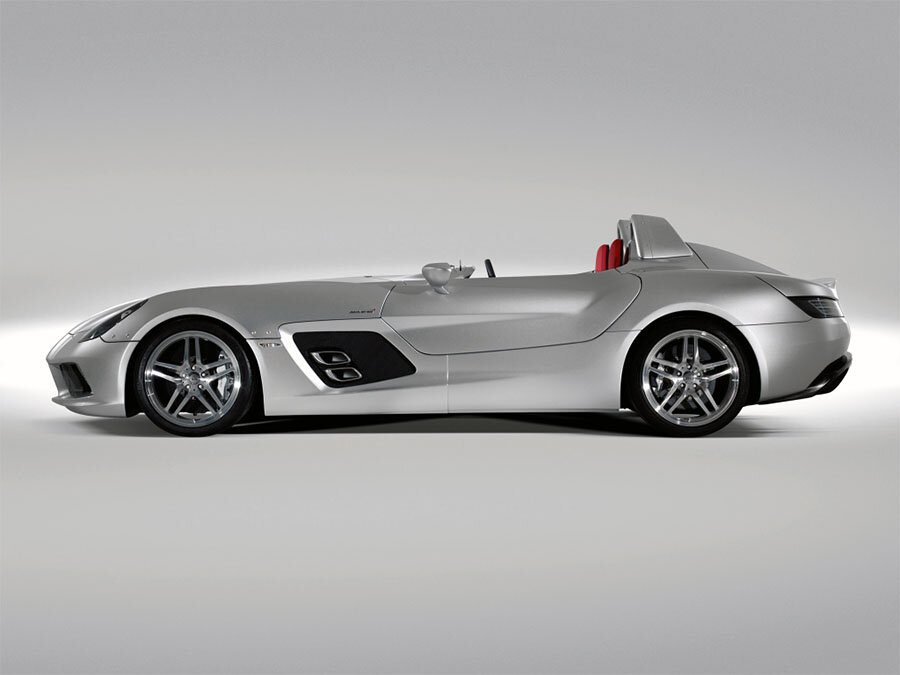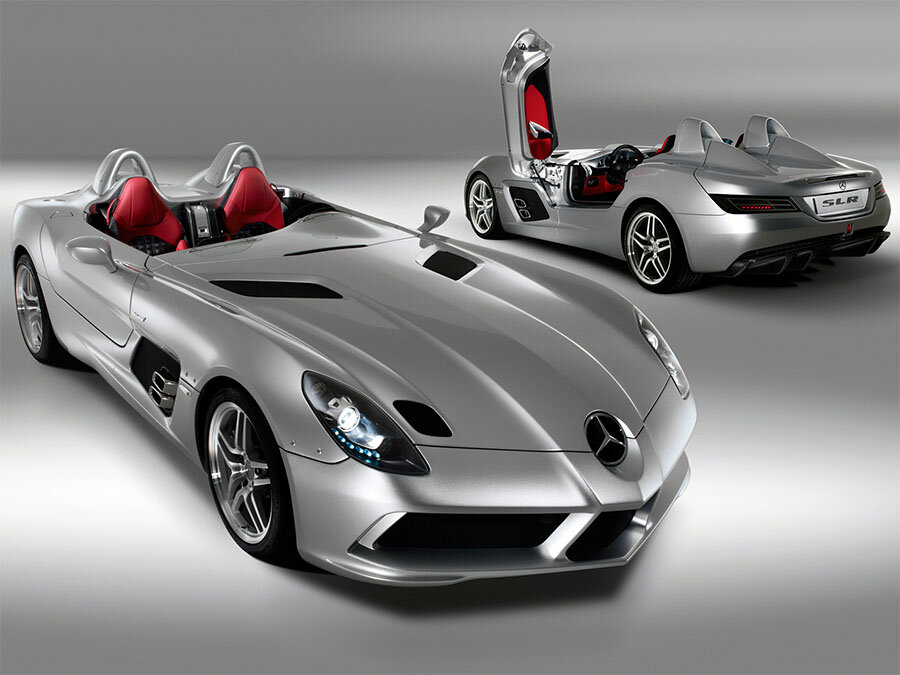Guide: Mercedes-Benz C199 SLR McLaren Stirling Moss - a Historical & Technical Appraisal
/BACKGROUND
At the Detroit Motor Show in January 2009, Mercedes-Benz launched the last SLR collaboration with McLaren. The resultant SLR McLaren Stirling Moss special edition was an extraordinary Speedster-bodied farewell tribute based on the underpinnings of the SLR 722 Edition.
Production was limited to 75 units.
At over $1m, the car (which had no roof, windscreen or side windows) was more than twice the price of a regular SLR Roadster. Nevertheless, the limited run instantly sold out; availability was limited exclusively to existing SLR customers.
The SLR Stirling Moss was inspired by arguably the most iconic and successful sports racing car of its era: the Mercedes-Benz Type W196S 300 SLR.
As its moniker hinted, the 300 SLR was an elaboration of Mercedes’ Type W196 Formula 1 car.
The SLR was campaigned for one gripping season (1955), during which it was involved in some of the most famous races of all time.
Perhaps the most highly regarded single performance of 1955 was that of Stirling Moss at the Mille Miglia.
Moss was accompanied by journalist, Denis Jenkinson, who navigated the 1000 mile route around the public highways of Italy with an innovative pace note system.
Moss and Jenkinson completed the event in a record time of ten hours and seven minutes.
Tragically, a few weeks later, the 300 SLR of Pierre Levegh crashed into the crowd at Le Mans. Levegh and 83 spectators were killed. Mercedes-Benz completely withdrew from motor racing at the end of 1955.
The Mille Mille was then banned after twelve people were killed in 1957. Moss and Jenkinson’s time was never beaten.
BODYWORK
A large factor that contributed to the SLR Stirling Moss edition’s enormous price was its sensational new carbonfibre body.
Korean stylist, Yool Il-hun, led the design team; the result was a raw, uncompromising Speedster, the like of which had not been seen for many years. Every panel was intricately contoured and the overall effect was highly reminiscent of the great front-engined Sportscar racing era.
Like those fifties machines, the SLR Stirling Moss had a partially enveloped open cockpit. Instead of a windscreen, two discrete translucent air deflectors were located ahead of the occupants. Behind each seat was a streamlined headrest and integrated roll over hoop.
A pair of tonneaus were supplied to cover the cockpit when not in use.
Myriad ducts and vents scattered around the car were painted black to contrast the otherwise silver paintwork.
Not a single panel was shared with the normal-bodied SLRs that had emerged thus far. Likewise, the underbody diffuser on the SLR Stirling Moss was new (and substantially enlarged).
As per the standard SLR variants, a retractable bootlid-mounted flap served as a combined spoiler / air brake. The flap automatically deployed at a variety of angles to increase rear downforce. It was also activated under hard braking to ensure optimum deceleration.
INTERIOR
Mercedes commissioned Dutch stylist, Sarkis Benliyan, to create the interior.
Surfaces were a mix of silver-painted composites, black and red leather, black carpet and exposed carbonfibre.
The layout was largely as before, but cosmetically, everything was re-styled.
The instrumentation was housed in silver painted domed shroud. Analague dials for engine and road speed were inset with an array of warning lights and digital read outs. The speedo and tach were flanked by smaller gauges for water temperature and fuel.
Custom one-piece bucket seats were trimmed in two-tone black red leather. The seat centres were quilted with contrast stitching.
In between was a simplified transmission tunnel and centre console complete with new gaited gear lever.
Each car was fitted with an aluminium plaque signed by Stirling Moss himself.
CHASSIS
A standard SLR carbonfibre reinforced plastic monocoque was retained.
Suspension was via aluminium double wishbones with coil springs and twin-tube gas-pressurised shock absorbers. A front anti-roll bar was fitted along with anti-dive and anti-squat geometry.
As per the 722 Edition, the SLR Stirling Moss came with improved steering and springs that were 15% stiffer than a regular SLR. Aluminium-shelled Koni dampers replaced the steel-shelled Bilstein units as well.
The net result was both the 722 and Stirling Moss had 10mm lower ride height, increased directional stability and less weight.
Special five twin-spoke forged aluminium wheels were unique to the Stilring Moss edition. They measured 19 x 9-inches at the front and 19 x 11.5-inches at the rear.
722-spec. carbon-ceramic brake discs were fitted all round. They had a 390mm diameter with eight-piston calipers at the front and 360mm diameter with four-piston calipers at the rear.
As usual, the Sensotronic Brake Control brake-by-wire system was fitted (to manage the anti-lock software and Brake Assist).
Traction control, electronic stability control, power steering and electronic tyre pressure monitoring were also standard equipment.
Dual aluminium fuel tanks with a combined capacity of 98-litres were installed above each side of the rear axle.
ENGINE / TRANSMISSION
At the heart of the car was another supercharged 90° V8.
For the 722 Edition (and subsequently the Stirling Moss), Bosch re-mapped their ME-2.8.1 engine management to further increase output.
The power unit was also given a bright red intake tract to differentiate it from the standard motor.
Peak output was 641bhp at 6500rpm and 605lb-ft at 4000rpm.
The hand-built Type M155.980 V8 used in the SLR was developed for Mercedes by AMG. It featured an all-alloy construction, single overhead camshafts and three valves per cylinder (two intake and one exhaust).
Displacement was 5439cc thanks to a bore and stroke of 97mm and 92mm respectively. The compression ratio was 8.8:1 and dry-sump lubrication was employed. A Teflon-coated IHI Lysholm twin-screw supercharger ran at 0.9 bar.
The engine was coupled to the same AMG Speedshift R five-speed automatic gearbox and dry single-plate clutch used in the standard SLR.
Two fully automatic modes were offered (Comfort and Sport) along with three different Manual settings (Sport, Supersport and Race). Each mode featured progressively shorter shift times than the one before.
In Manual mode, gear changes could be activated by buttons on the steering wheel or using the Touchshift lever on the transmission tunnel.
WEIGHT / PERFORMANCE
At 1598kg, the SLR Stirling Moss edition was 170kg lighter than a standard Coupe. It was also a substantial 126kg less than the 722 Edition Coupe.
The top speed and 0-62mph time were quoted as 217mph and 3.5 seconds respectively.
PRODUCTION
Production began in June 2009 immediately after production of the standard-bodied SLR variants had ended.
The final SLR Stirling Moss edition was completed in December 2009.
As per the entire SLR production run, all 75 cars were left-hand drive.
Text copyright: Supercar Nostalgia
Photo copyright: Mercedes-Benz - https://www.mercedes-benz.com




































